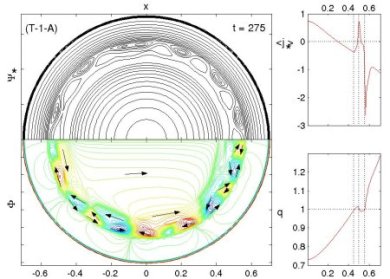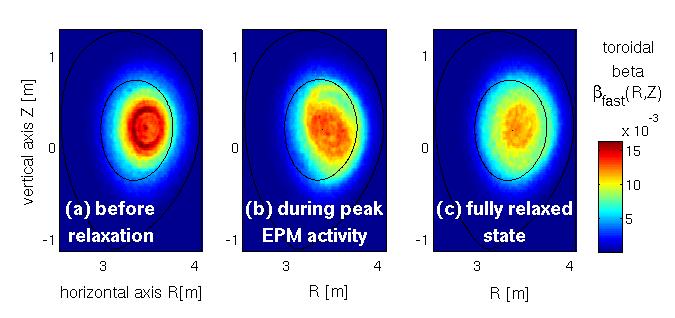Menu
- Theory and Simulation
- Numerical EXperiment Tokamak (NEXT) Project
- Staff List
- References
- NEXT Workshop
Plasma Theory and Simulation Group
Name : Andreas Bierwage
Title : Senior Principle Researcher, Concurrent Staff of Advanced Plasma Modeling Group
Address : 801-1 Mukoyama, Naka-shi, Ibaraki, 311-0193, JAPAN
Research Title
- Study of relaxation phenomena in tokamak plasmas
- Development of numerical methods and tools for predictive simulations
1. Study of relaxation phenomena in tokamak plasmas
1.1 Overview
Relaxation events may be loosely defined as follows. They consist of
- a relatively slow "ramp/recovery phase" during which some kind of energy is accumulated, and
- a relatively fast "relaxation phase" during which the accumulated energy is suddenly released.
During the relaxation phase, measurable quantities such as density or temperature of certain plasma species and electric or magnetic fields are strongly perturbed; that is, the fluctuation amplitude briefly rises significantly above that of the "usual turbulent background". My general research interests are strongly influenced by the goal to understand the physical processes that lead to such behavior and develop the ability to predict the onset and magnitude of a relaxation event, and its effect on the confinement properties of the plasma.
Until now, I have studied two types of relaxation events:
- current-gradient-driven internal disruptions related to so-called "sawtooth oscillations" (see Section 1.2), and
- relaxations of the energetic ion population due to Alfvénic modes driven by the energetic ions themselves (see Section 1.3).
A short outline of each topic is given below, along with a list of selected references.
1.2 Role of multiple q=1 rational surfaces on the dynamics of the internal kink mode during sawtooth crashes
When there are multiple nearby surfaces with q=1, coupled double and triple kink-tearing modes become unstable and may grow faster than the m=1 internal kink mode. It is demonstrated that in such cases magnetic reconnection is at least initially limited to an annular region between and nearby the original q=1 surfaces, as shown in Fig.1.1. The reconnection of the central plasma region is at least delayed, since the annular profile flattening removes the drive from the m=1 mode. It is suggested that this mechanism may play a role in experimentally observed partial reconnection events, where the central value of the q profile remains well below unity [1].
In a series of subsequent papers, the role of higher-harmonic multiple kink-tearing modes is studied in cases with q>1, with dominant collisionless reconnection, and with strong shear flow localized between pairs of rational surfaces with the same q value [2-6].
In 2012, an experimental campaign was launched at KSTAR with the goal to examine the possibility that multiple tearing modes cause the formation of multiple flux tubes that were observed in ECE images. It is conjectured that off-axis current drive due to ECRH may produce a non-uniform q profile with multiple q=1 surfaces.

Fig.1.1: A snapshot of the nonlinear mode structure in the poloidal (X,Y) plane produced by a broad spectrum of double and triple kink-tearing modes with helicity m/n=1 is shown. The helical flux contours are shown in the top-left and the electric potential of the ExB flow in the bottom-left panel. The panels on the right show the instantaneous profiles of the current density (top) and safety factor (bottom). The original configuration has a central safety factor q(r=0) of about 0.7, three nearby q=1 rational surfaces, and the fastest growing harmonics have poloidal and toroidal mode numbers around m=n=13.
References for section 1.2
[1] "Nonlinear evolution of q=1 triple tearing modes in a tokamak plasma" A. Bierwage et al, Phys. Rev. Lett. 94, 065001 (2005).
[2] "Fast growing double tearing modes in a tokamak plasma" A. Bierwage et al, Phys. Plasmas 12, 082504 (2005).
[3] "Nonlinear evolution of the m=1 internal kink mode in the presence of magnetohydrodynamic turbulence" A. Bierwage et al, Phys. Plasmas 13, 032506 (2006).
[4] "Comparison between resistive and collisionless double tearing modes for nearby resonant surfaces" A. Bierwage and Q. Yu, Plasma Phys. Control. Fusion 49, 675 (2007).
[5] "Dynamics of resistive double tearing modes with broad linear spectra" A. Bierwage et al, Phys. Plasmas 14, 022107 (2007).
[6] "Large-mode-number magnetohydrodynamic instability driven by sheared flows in a tokamak plasma with reversed central shear" A. Bierwage, Q. Yu and S. Guenter, Phys. Plasmas 14, 010704 (2007).
1.3 Nonlinear simulation of energetic particle modes in JT-60U
Energetic Particle Modes (EPM) are Alfvénic wave packets that are resonantly excited by fast ions in toroidally confined plasmas. In contrast to fast-ion driven Alfvén eigenmodes (AE), which have a mode structure and frequency dictated by the bulk plasma, the properties of the EPM are strongly influenced by the form and evolution of the fast ion distribution in phase space. They are usually found near the Alfvén continua, can reach large growth rates comparable to the value of their linear oscillation frequency, and undergo convective amplification during the nonlinear regime. Furthermore, EPM can cause strong deformations in the fast ion distribution and significant particle transport, as illustrated in Fig.1.2.
Numerical simulations have shown that an n=1 EPM may be the fundamental instability underlying Abrupt Large-amplitude relaxation Events (ALE) observed in N-NB driven JT-60U discharges. We have developed increasingly realistic models to study the dynamics of EPM in the ALE scenario. Specifically, we use a numerically computed magnetic geometry and fast ion distributions computed by an orbit-following Monte-Carlo code. Particles are followed even in the vacuum region in order to avoid spurious effects of an artificial boundary. The influence of magnetic geometry as well as bulk plasma pressure and compressibility on the properties of an n=1 EPM was examined [1,2]. Currently, we are looking for the mechanism that may trigger ALE in JT-60U [3].

Fig.1.2: Snapshots of the evolution of the fast ion pressure field (a) before, (b) during, and (c) after the relaxation of the energetic ion population caused by an n=1 EPM with dominant poloidal harmonics m=1,2,3. Color contours of the toroidal fast ion beta in the poloidal (R,Z) plane are plotted along with (black) contours of the magnetic flux surfaces at r/a=0.5 and at the plasma boundary.
References for section 1.2
[1] "Nonlinear hybrid simulations of energetic particle modes in realistic tokamak flux Surface Geometry" A. Bierwage et al, Plasma Fus. Res. 6 2403109 (Special Issue 1) (2011).
[2] "Nonlinear simulation of energetic particle modes in high-beta tokamak plasma" A. Bierwage et al, Plasma Fus. Res. 7 2403081 (Special Issue 1) (2012).
[3] "Role of convective amplification of n=1 energetic particle modes for N-NB ion dynamics in JT-60U" A. Bierwage et al, submitted to Nucl. Fus. (2013).
2. Development of numerical methods and tools for predictive simulations
2.1 Overview
Predictive simulations should not only give information about what may happen, but also about what will happen under certain conditions and whether it will matter from the practical point of view. Usually, this requires detailed modeling of the simulation scenario, besides the careful numerical solution of the equations that govern the dynamics.
In order to expand our qualitative and quantitative predictive capability for the interaction of energetic ions with Alfvénic modes and the resulting energetic ion transport, a numerical tool called VisualStart has been developed. VisualStart is designed to
- gather data for the magnetic equilibrium geometry and energetic ion phase-space distribution,
- allow the user to process and analyze these data via a convenient Graphical User Interface (GUI), and
- produce a snapshot of the plasma that serves as an initial condition for a nonlinear initial value solver.
The tool includes modules to analyze the continuous Alfvén spectra, unperturbed particle trajectories both inside the plasma and in the surrounding vacuum, and distribute simulation particles in the phase space using a low-noise sampling method (section 2.2).
2.2 Orbit-based marker loading method
In earlier linear 1-D flux tube simulations of energetic ion driven Alfvén modes, it was found that uniformly random loading of marker particles along the field line coordinate caused excessive "noise" that may even be correlated with the signal. The problem was solved by loading the particles uniformly in time rather than in space. This ensures minimal variation of the number of simulation particles in each cell. This method was now generalized to be applied for global 3-D simulations [1] by loading simulation particles as illustrated in Fig.2.1.

Fig.2.1: Poloidal (X,Y) plane with two "neighboring" trapped particle trajectories. The two trajectories have the same kinetic energy and pitch angle coordinate (E,A), but slightly different canonical momenta p. The surfaces covered by these two orbits encompass a volume element. This volume element is divided into (here 16) sub-volume elements, which are represented by marker particles. The divisions are made at constant time intervals, so that the marker particle density remains constant in each cell as long as the fields are not perturbed.
